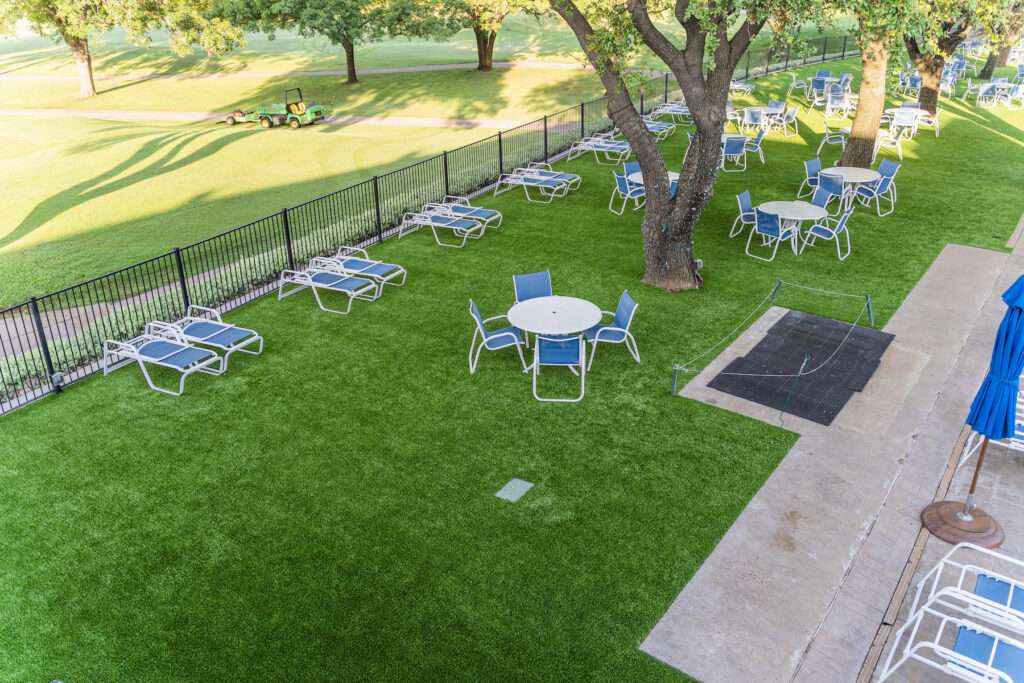
Synthetic, or artificial, grass can provide many benefits during both wet and dry weather or in humid or arid environments. Artificial turf’s benefits extend to all weather conditions and any temperature. This versatility is causing a surge in artificial grass interest among both homeowners and businesses looking to maintain a good-looking turf environment no matter the moisture level or temperature. The benefits of synthetic grass or “AstroTurf” in both wet and dry weather conditions are beginning to be more widely known. Homeowners and businesses are increasingly discovering that how long it takes for turf to dry is significantly reduced with artificial grass, enhancing its appeal.
The media has, at times, featured an artificial grass lawn or area in an arid desert xeriscape environment, and it looks spectacular. The synthetic turf stands out from all the brown sand, dirt, and rocks typical of many arid landscapes. Additionally, synthetic turf can be a real money saver in arid climates since water is so scarce and expensive. However, artificial grass is also excellent for wet, humid environments. As any pet owner who has experienced artificial grass in rainy conditions can attest, it’s much easier to clean shoes or a pet off after they have been on synthetic grass versus a muddy lawn. Artificial turf is truly turf for all weather conditions, making it a reliable choice for both homeowners and business owners.
There are many reasons why artificial grass is becoming more popular with homeowners and businesses for any weather conditions, but 10 of the most frequently discussed reasons are listed below.
5 Artificial Grass Benefits during Wet Weather:
- Improved Drainage: Artificial turf with permeable backing and fill often features much better drainage than most grass. Where puddles can often form on natural grass yards, artificial grass installations are designed and installed to wick away up to 30 inches of water per square yard.
- Mud-Free: With synthetic grass, gone are the days of people and pets tracking mud into the home on their shoes or paws. Artificial grass doesn’t turn into a muddy mess during wet weather from oversaturation or pet or people traffic. This ensures a clean, mud-free, and usable surface during or after rainfall without creating a mess.
- Quick Drying: It can days or even weeks for natural grass and dirt to dry and not be muddy. This limits yard or common area use until the grass dries and the ground firms up again. With artificial grass, the drying process is fast and the area can be utilized with no or little wait.
- Erosion Control: Artificial grass provides a tough and durable layer of protection between the elements and the ground. With this additional buffer, erosion is hard-pressed to have its way. The added stability that artificial turf provides will result in less maintenance and repair costs in the long run.
- No Grass Damage: When natural grass becomes too saturated with moisture it can be easily damaged, uprooted, or prone to mold, mildew, or fungus. Artificial turf doesn’t typically experience these problems and is ready for foot traffic almost immediately after inclement weather.
5 Artificial Grass Benefits during Dry Weather:
- Water Conservation: Artificial grass requires minimal water. Occasionally it is good to hose off artificial turf to rinse dirt and debris away, and weekly if pets use the turf, but compared to a natural grass lawn that needs upwards of 1.5 inches of moisture each week during the summer, thousands of gallons of precious water can be saved each week during the hot months of the year. Artificial turf dramatically helps with water conservation for all areas of the country, but especially for those regions facing drought or water scarcity.
- Saves Money: Water is a natural resource that continues to get more expensive. There is only a finite amount of fresh water on this planet and artificial grass installation can recoup a lot of its original cost by saving on irrigation costs.
- Consistent Appearance: Synthetic grass maintains a lush, green appearance throughout the year, no matter what the weather and temperature. This can be particularly advantageous during dry periods or during the winter when natural grass will go dormant and turn brown.
- Reduced Allergens: There can be many allergens associated with natural grass that can cause allergic reactions and discomfort for those with allergies. Artificial grass can provide relief from allergens by minimizing them, especially during dry weather when allergen levels may be higher.
- Durability: Artificial turf is more resilient to extreme weather conditions, including heat and drought. It doesn’t become dry, or brittle and die off like natural grass can. Synthetic grass also doesn’t become too saturated in wet conditions and isn’t typically prone to mold, mildew, or fungus when installed and maintained properly. It is more aesthetically pleasing during extreme conditions and tolerates a lot more foot and animal traffic.
In summary, artificial grass offers numerous benefits in many weather conditions, whether wet or dry. Synthetic grass provides a versatile, low-maintenance and ultimately less expensive alternative to natural grass, and artificial turf’s ability to resist both mud and drought makes it an appealing choice for a wide range of uses and climates.